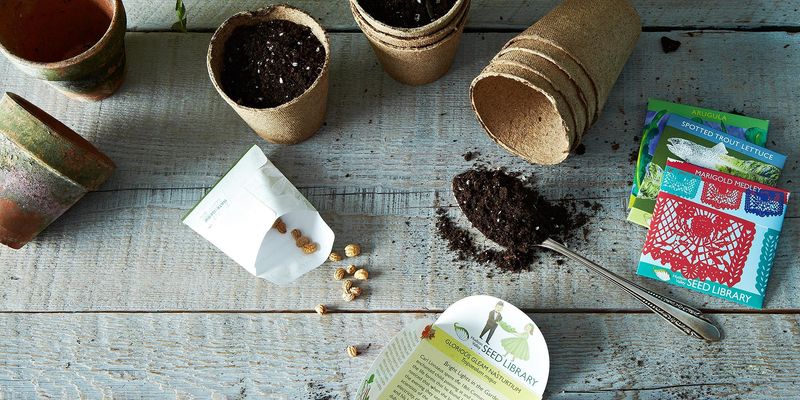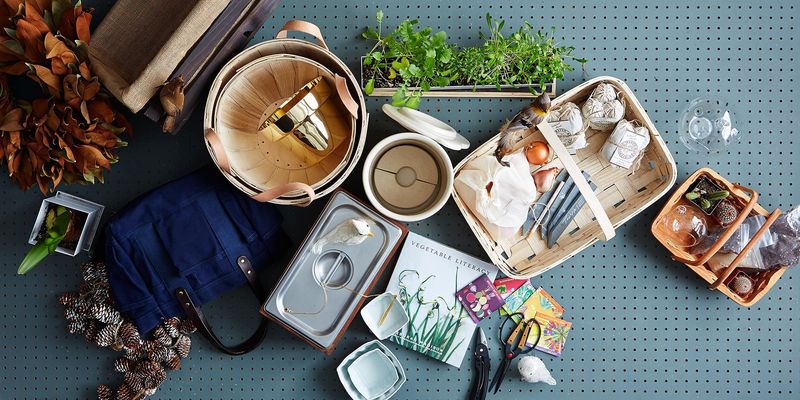The decision to begin a garden feels a bit like what I imagine the decision to skydive or bungee jump feels like: You’re excited! You have a vision! You make arrangements for the day you’ll do the skydiving/bungee-jumping/gardening deed and then it comes, and you approach the edge of the plane door/cliff/plot and suddenly your heart is pumping and all you can think is What. Have. I. Done.
Tighten your harness. Take a deep breath. You’ve got a team of trained professionals right behind you: author and small-space gardening expert Marie Viljoen; Ceci de Corral, the design and installations manager at the rooftop farm and educational center Brooklyn Grange; and the author and gardener Alex Mitchell.
Here are 23 of their best tips for starting your first garden:
On getting started

Food52/James Ransom
1. Just start. “Really, just start. Buy a pot. Buy potting soil,” says Viljoen. You’ll already be halfway to a garden by the time you decide what to plant in it.
2. Read up. “Educate yourself on the veggies you are choosing and their needs,” de Corral says. She learned the hard way that the tomato plants on the Brooklyn Grange, which get full sun, were extremely happy, while the tomatoes in her shady backyard refused to bear fruit. And that said …
3. Take notes, and look back on them every season. This is one of de Corral’s biggest tips: Learn from your mistakes and successes; get yourself a journal and take careful note of what does and doesn’t work. You’ll not only have a record of what you grew every year, but you’ll also be able to track your progress (and only plant winners).
4. Seek out help from resources. “Ask questions at your nursery or reach out to companies like Brooklyn Grange!” says de Corral. Others have recommended local extension services or master gardeners. A brick-and-mortar nursery (and the people who staff it) is one of Viljoen’s favorite resources.
5. And use your neighbors as resources. Mitchell advises looking at the gardens around your neighborhood: “Chances are, that’s what will grow well in your garden too.”
6. Know your conditions, but don’t be intimidated by them. At first, de Corral was nervous that growing would be harder or harsher or less successful or more taxing in an urban environment. “But as it turns out, the basics are still the same: Plant a seed, make sure it’s getting adequate light and water, let nature do the rest,” she says.
7. That includes your soil. This is especially important if you live in a city, says Viljoen, who tends an impressively productive garden in her Brooklyn backyard. Get your soil tested! This will help guide you toward what to plant (or not). In addition to the mineral and chemical composition, learn whether it’s wet or dry, sandy or clay-rich.

Food52/Mark Weinberg
On what to grow
1. Learn your aspect. That’s the direction — north, south, east, or west — your garden faces, says Viljoen. And that will affect the kind of light your garden will get, and what will grow well there.
2. Embrace the power of threes. “Over the years I’ve discovered that planting one of everything looks messy,” says Mitchell — even if you’re aiming for a relaxed-looking garden. “You get a lot more impact if you select a handful of great plants and repeat them throughout the garden in groups of three.” (Bonus: Choosing only a handful of plants means fewer disparate plant needs to juggle.)
3. Let the labels lead you. “The labels [on seed packets and seedlings] are there for a reason,” says Mitchell. “If it says a plant ‘requires full sun’ and you only have a shady patch under a fire escape, choose something else. If it isn’t ‘frost hardy,’ don’t expect it to sail through a snowstorm.”o
4. But don’t be discouraged by shade. “I learned you can grow runner beans with just four hours of sun,” Viljoen says. Many herbs will do well, too. Just because tomatoes won’t grow in shade doesn’t mean lots of other things won’t.
5. California poppies have been deeply rewarding for Mitchell. “Sown once, never forgotten,” she says. “They come back year after year, popping up in unexpected places, and are such a gorgeous saturated orange.” (Nota bene: Make sure you have the right climate for them!)
6. Daily pick-your-own salad can be yours. Greens are one of Viljoen’s favorite things to grow — and they grow quickly, which means near-instant gratification. “Last year, I was gathering daily arugula and mustard,” she says.
7. Strawberries do very well — even in pots, even in the shade, says Viljoen. If you have sun, look for everbearing strawberries, which produce fruit all summer. If you have more shade, look for Alpine strawberries like fraises des bois, which are tiny shade-adapted strawberries.
On keeping it alive
1. There’s a reason — and a solution — for every problem. “And it’s usually much easier to fix than you think,” says de Corral. “Don’t be intimidated! Look at your struggling basil plant as an opportunity to learn that basil likes light and humidity, or your yellowing greens to research the importance of nitrogen in soil.”
2. Make the roots feel at home. As soon as you transplant something — that is, move it from a pot to a plot of soil or vice versa, water it, says Viljoen.
3. Do nothing. Well, not nothing, but a hands-off approach, one in which nature takes the reins, is a good one, advises Mitchell. Watch carefully: You’ll learn what’s growing well in the spot where you’re hoping to plant your garden, and then you can make plans from there. And you may be surprised: “That boring bunch of twigs in December may turn into a beautiful flowering shrub in the spring. Don’t chop things down before you’re absolutely sure they’re not going to do something lovely at some point in the year.”
4. Drainage, drainage, drainage! “Don’t forget to make drainage holes in pots,” pleads Mitchell. Most plants in pots need a place for extra water to go; this will prevent against drowning them. Choose pots that already have drainage holes, or poke them out yourself.
5. Err on the side of under-watering. “If you’re under-watering, the plant tells you immediately, ‘Hey, I’m droopy, give me water’,” says Viljoen. “Other way around, you don’t realize until it’s almost too late.”
On enjoying it
1. Concentrate on completing one manageable task rather than trying to tackle the whole garden at once, says Mitchell. “It’s easy to go out into the garden and feel overwhelmed, then drift around doing lots of things not very well — weeding a bit here, pruning a bit there.” Instead, tackle one smaller thing fully and well. Mitchell recommends planting a container or sowing a row of lettuces.
2. Remember that learning the hard way can be the best way to learn, says de Corral. You’re going to kill some plants. It’s OK. Next year, you’ll kill fewer plants, and the next year, fewer: You’re not likely to put tomatoes in full shade again once you realize that they’re not so successful there.
3. Let it go. “Remember nature never stands still,” says Mitchell, and therefore, “your garden will never be perfect.” Embrace this, but don’t focus on it: Instead of focusing on the things that don’t work, devote time to and derive joy from the things that do — “and your garden will be a place of pleasure not pain!”
4. Think of your garden the same way you’d think of a relationship with a person, says Viljoen. “If you take it for granted, it’s going to go south pretty quickly. They need the gardener every day.”




